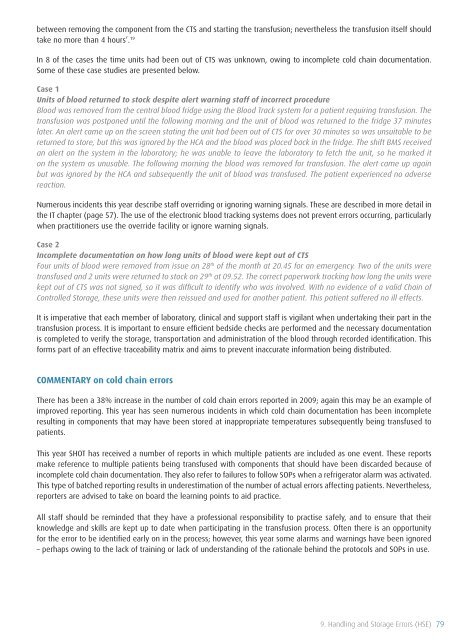SHOT Annual Report 2009 - Serious Hazards of Transfusion
SHOT Annual Report 2009 - Serious Hazards of Transfusion
SHOT Annual Report 2009 - Serious Hazards of Transfusion
Create successful ePaper yourself
Turn your PDF publications into a flip-book with our unique Google optimized e-Paper software.
etween removing the component from the CTS and starting the transfusion; nevertheless the transfusion itself should<br />
take no more than 4 hours’. 19<br />
In 8 <strong>of</strong> the cases the time units had been out <strong>of</strong> CTS was unknown, owing to incomplete cold chain documentation.<br />
Some <strong>of</strong> these case studies are presented below.<br />
Case 1<br />
Units <strong>of</strong> blood returned to stock despite alert warning staff <strong>of</strong> incorrect procedure<br />
Blood was removed from the central blood fridge using the Blood Track system for a patient requiring transfusion. The<br />
transfusion was postponed until the following morning and the unit <strong>of</strong> blood was returned to the fridge 37 minutes<br />
later. An alert came up on the screen stating the unit had been out <strong>of</strong> CTS for over 30 minutes so was unsuitable to be<br />
returned to store, but this was ignored by the HCA and the blood was placed back in the fridge. The shift BMS received<br />
an alert on the system in the laboratory; he was unable to leave the laboratory to fetch the unit, so he marked it<br />
on the system as unusable. The following morning the blood was removed for transfusion. The alert came up again<br />
but was ignored by the HCA and subsequently the unit <strong>of</strong> blood was transfused. The patient experienced no adverse<br />
reaction.<br />
Numerous incidents this year describe staff overriding or ignoring warning signals. These are described in more detail in<br />
the IT chapter (page 57). The use <strong>of</strong> the electronic blood tracking systems does not prevent errors occurring, particularly<br />
when practitioners use the override facility or ignore warning signals.<br />
Case 2<br />
Incomplete documentation on how long units <strong>of</strong> blood were kept out <strong>of</strong> CTS<br />
Four units <strong>of</strong> blood were removed from issue on 28 th <strong>of</strong> the month at 20.45 for an emergency. Two <strong>of</strong> the units were<br />
transfused and 2 units were returned to stock on 29 th at 09.52. The correct paperwork tracking how long the units were<br />
kept out <strong>of</strong> CTS was not signed, so it was difficult to identify who was involved. With no evidence <strong>of</strong> a valid Chain <strong>of</strong><br />
Controlled Storage, these units were then reissued and used for another patient. This patient suffered no ill effects.<br />
It is imperative that each member <strong>of</strong> laboratory, clinical and support staff is vigilant when undertaking their part in the<br />
transfusion process. It is important to ensure efficient bedside checks are performed and the necessary documentation<br />
is completed to verify the storage, transportation and administration <strong>of</strong> the blood through recorded identification. This<br />
forms part <strong>of</strong> an effective traceability matrix and aims to prevent inaccurate information being distributed.<br />
COMMENTARY on cold chain errors<br />
There has been a 38% increase in the number <strong>of</strong> cold chain errors reported in <strong>2009</strong>; again this may be an example <strong>of</strong><br />
improved reporting. This year has seen numerous incidents in which cold chain documentation has been incomplete<br />
resulting in components that may have been stored at inappropriate temperatures subsequently being transfused to<br />
patients.<br />
This year <strong>SHOT</strong> has received a number <strong>of</strong> reports in which multiple patients are included as one event. These reports<br />
make reference to multiple patients being transfused with components that should have been discarded because <strong>of</strong><br />
incomplete cold chain documentation. They also refer to failures to follow SOPs when a refrigerator alarm was activated.<br />
This type <strong>of</strong> batched reporting results in underestimation <strong>of</strong> the number <strong>of</strong> actual errors affecting patients. Nevertheless,<br />
reporters are advised to take on board the learning points to aid practice.<br />
All staff should be reminded that they have a pr<strong>of</strong>essional responsibility to practise safely, and to ensure that their<br />
knowledge and skills are kept up to date when participating in the transfusion process. Often there is an opportunity<br />
for the error to be identified early on in the process; however, this year some alarms and warnings have been ignored<br />
– perhaps owing to the lack <strong>of</strong> training or lack <strong>of</strong> understanding <strong>of</strong> the rationale behind the protocols and SOPs in use.<br />
9. Handling and Storage Errors (HSE) 79












